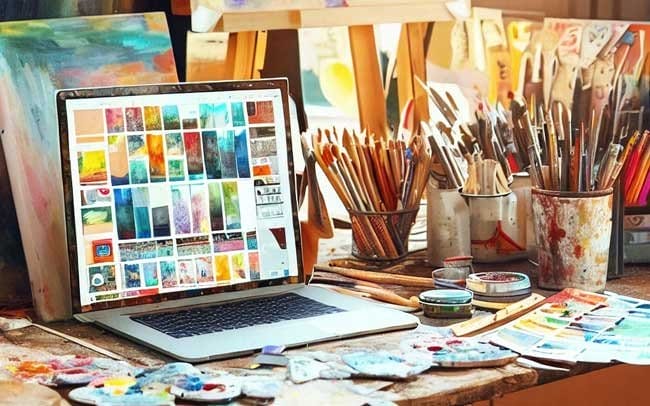
Step right into the world of limitless possibilities with our tailored 7-step guide, exclusively designed for artists like you, aiming to conquer the Facebook platform. Unveil the secrets to make your mark, captivate your audience, and turn your creative spark into a thriving venture, all through the power of Facebook.
These seven potent strategies are the keys to the kingdom. You’re not just creating a presence on Facebook, you’re building a bridge that connects your art to the hearts and minds of your audience. Seize this chance to convert admirers into customers, bringing your unique pieces into their world. Let’s embark on this journey to success together. Your art has a story to tell; let’s amplify it through Facebook.
Step 1: Building Your Professional Facebook Page
Every successful journey on Facebook begins with setting up a professional page. Think of this as your digital art gallery where fans and potential customers can appreciate your work and interact with you. Let’s dive into the details of creating an engaging and appealing page.
Selecting Profile and Cover Photos
The next step involves choosing a profile picture and a cover photo. Make sure these images are clear, attractive, and represent your art style well. You might consider using a high-quality image of one of your signature pieces, or perhaps a professional photo of you in your workspace.
Crafting Your ‘About’ Section
Your ‘About’ section is your opportunity to share your artistic journey and identity with your audience. Highlight what motivates you as an artist, your unique style, and the story behind your creations. The more engaging your narrative, the more your audience will want to connect with you and your art.
Fin out more about Pinterest as a Platform for Artists to promote their work in out post Pinterest for Artists.
Adding a Link to Your Portfolio
Don’t forget to include a link to your online portfolio or website in your profile. This will allow interested viewers to explore your body of work in more depth, and perhaps make a purchase.
Setting up your professional Facebook page is the crucial first step in promoting and selling your art on Facebook. It serves as your virtual storefront and sets the tone for your online presence, so take the time to get it right.
Step 2: Consistently Posting Quality Content
In the second step of our strategy, we focus on sharing your art and your story with the world. This step is all about regularly posting high-quality content that showcases your work and invites your audience into your artistic process. Let’s discuss how to do this effectively and efficiently.
Why Consistency and Quality Matter
Maintaining a consistent posting schedule is crucial on Facebook. It keeps your page fresh in the minds of your audience, encouraging them to engage with your work more often. In addition to being consistent, you should ensure that the content you share is of high quality. Clear, well-lit images that show your art in its best light are a must.
What to Post
In terms of content, your primary focus should be showcasing your artwork. Share images of finished pieces, progress shots, and maybe even a few snippets from your sketchbook. The goal is to give viewers a full view of your work and artistic process.
However, your content shouldn’t be limited to images of your art. Share posts about your inspiration, your artistic journey, upcoming exhibitions or events, and even casual behind-the-scenes moments from your studio. This variety of content keeps your page interesting and helps your audience feel more connected to you as an artist.
Writing Engaging Captions
Don’t underestimate the power of a good caption. While the images of your artwork will draw people in, the captions can deepen their engagement. Use this space to tell stories about your artwork – the inspiration behind a piece, the process of creating it, or the meaning it holds for you. This can make your art more relatable and engaging to your audience.
Planning and Scheduling Your Posts
To ensure consistency, it’s a good idea to plan and schedule your posts ahead of time. Facebook has a built-in feature that allows you to schedule posts, so you can create a bunch of posts at once and then let them go live at predetermined times. This way, even on days when you’re busy in the studio, your Facebook page stays active.
Following these strategies for consistent content posting will help keep your audience engaged, build a stronger connection with them, and ultimately enhance your chances of selling your art on Facebook.
Step 3: Engaging with Your Audience
Once you have your professional page set up and a content posting strategy in place, the next step in successfully promoting your art on Facebook is audience engagement. In this stage, we’ll explore how to interact with your followers, build strong relationships, and create an active community around your art.
Responding to Comments
One of the easiest ways to engage with your audience is by responding to comments on your posts. This could be as simple as thanking someone for their compliment, answering a question about your art, or simply acknowledging that you’ve seen and appreciated their comment. By doing this, you show your followers that you value their feedback and interest in your work.
Encouraging Interaction
Besides responding to comments, you should also aim to encourage further interaction. Ask questions in your posts to invite responses, such as asking for opinions on a piece of art, or what kind of content your audience would like to see next. This will not only increase engagement on your page but will also provide valuable insights into your audience’s preferences.
Going Live
Facebook’s “Live Video” feature is a powerful tool for real-time engagement. Use this feature to host live Q&A sessions, provide behind-the-scenes tours of your workspace, or showcase live art creation processes. These live sessions make your audience feel more connected to you and your art, and they can also attract a wider audience.
Fostering a Community
By consistently engaging with your followers, you can build a vibrant community around your art. This community will not only support you by liking and sharing your posts, but they may also become customers, purchasing your art because they feel a connection to you and your work.
By taking the time to engage with your audience, you not only build a supportive community around your art but also create relationships with potential customers. This can go a long way in helping you promote and sell your art on Facebook.
Step 4: Utilizing Facebook Ads
Your professional page is now set up, your content is engaging, and your community is growing. The fourth step to promoting your art on Facebook is leveraging the power of Facebook Ads. This tool allows you to extend your reach beyond your immediate followers, potentially attracting new fans and customers.
Understanding Facebook Ads
Facebook Ads allow you to promote your posts or page to a wider audience. This is not just any audience, but one you can specifically target based on interests, demographics, and behaviors. So, for instance, if your art style tends to attract a certain age group or if it’s particularly appealing to fans of certain art genres, you can target your ads to reach these exact people.
Creating Engaging Ads
Creating an engaging ad is key to grabbing the attention of your targeted audience. Your ad can showcase your artwork, highlight a current sale or exhibition, or tell a compelling story about your art. Regardless of what you choose to promote, make sure the ad is visually striking and has a clear call to action.
Retargeting with Facebook Ads
A powerful feature of Facebook Ads is the ability to retarget individuals who have previously interacted with your page or your website. This means you can show ads to people who have already shown an interest in your art, making them more likely to engage with your ad or make a purchase.
Monitoring Your Ads
Finally, it’s important to monitor your ads to see how well they’re performing. Facebook provides metrics such as reach, impressions, and engagement, which can give you insight into how your ads are doing. This can help you tweak your future ads for even better results.
By harnessing the power of Facebook Ads, you can reach a wider audience, attracting new fans and potential customers to your page. This can significantly boost your exposure and increase your chances of selling your art on Facebook.
Step 5: Joining Facebook Groups
Introduction
Moving on to step five of our Facebook strategy for artists, it’s time to explore the realm of Facebook Groups. These are places where like-minded individuals gather to share and discuss their common interests. As an artist, joining the right Facebook Groups can help you network, learn, and promote your art in a supportive environment.
Finding the Right Groups
There are thousands of Facebook Groups out there, so the first step is to find the ones that align with your art style, potential customers, and personal interests. These could be groups dedicated to the type of art you create (like abstract painting or landscape photography), groups for local artists, or even groups that discuss themes you explore in your art.
Being an Active Member
Once you’ve joined a group, don’t just be a silent observer. Engage with the community. Comment on others’ posts, participate in discussions, and whenever relevant, share your own work. Always make sure you’re adhering to the group’s rules and norms when posting.
Promoting Your Art
In many groups, self-promotion is allowed, but there’s usually a right way and a wrong way to go about it. Blatant self-promotion is often frowned upon, while sharing your art in a way that contributes to the discussion is more accepted. Learn the rules of each group and respect them. When you do share your work, make sure it’s in a way that adds value to the group.
Creating Your Own Group
If you’ve gained a substantial following, consider creating your own Facebook Group for your fans. This can be a place where they can discuss your work, where you can share exclusive content, and where you can interact with your fans on a more personal level.
Being part of Facebook Groups can provide you with invaluable exposure, feedback, and support from fellow artists and art lovers. It’s a great way to build your reputation, grow your audience, and ultimately, sell more of your art on Facebook.
Step 6: Collaborate with Other Artists
For our sixth step, we’re shifting our focus from individual work to collaborative efforts. Collaboration with other artists can offer fresh perspectives, increase your reach, and add a communal dimension to your art-making. It’s all about combining strengths and creating something unique together.
Finding the Right Collaborators
Look for fellow artists whose work you admire and with whom you believe you could create something exciting. They could be artists whose style complements yours, artists you’ve met in Facebook groups, or even artists you’ve been following and interacting with for a while. Reach out to them with your collaboration idea, and see if they’re interested.
Planning Your Collaboration
Once you’ve found someone to collaborate with, the next step is to plan your project. This could be creating a piece of art together, hosting a joint live session where you both create and talk about art, or even launching a joint exhibition or sale. Whatever it is, make sure it’s something both of you are excited about and that it aligns with both of your artistic brands.
Promoting Your Collaboration
As the collaboration takes shape, start promoting it on your Facebook page. Share teasers about what you’re working on, talk about your collaborative process, and build anticipation among your followers. Encourage your collaborator to do the same on their page.
Engaging with Both Audiences
Through collaboration, you have the opportunity to engage with a whole new audience – the followers of your collaborator. Make sure to interact with these new audience members, responding to their comments and showing appreciation for their interest.
Sharing the Final Product
When the collaboration is complete, share the results on your page and tag your collaborator. Encourage your followers to visit your collaborator’s page and vice versa. This cross-promotion can help you gain new followers and potential customers.
Collaborating with other artists can be a rewarding experience, both artistically and promotionally. It’s a unique way to create new art, reach new audiences, and make meaningful connections in the art world. Remember, success on Facebook and in the art world isn’t just about competition; it’s also about community and collaboration.
Step 7: Utilize Facebook Shop
As we reach the final step of our Facebook strategy for artists, it’s time to tap into the potential of Facebook Shop. This feature allows you to showcase and sell your art directly on your Facebook page, providing a seamless shopping experience for your followers.
Setting Up Your Facebook Shop
Begin by setting up a Facebook Shop through your professional page. You’ll need to add product listings for your art, including high-quality images, detailed descriptions, prices, and shipping information. Ensure all the details are accurate to avoid any confusion or misunderstandings with potential buyers.
Promoting Your Shop
Once your Shop is up and running, promote it to your audience. Highlight it in your posts, include a link in your page’s bio, and use Facebook Ads to promote your shop or specific products. The more visibility your Shop has, the more likely it is to attract customers.
Updating Your Shop Regularly
Just as with posting content, it’s crucial to keep your Facebook Shop updated. Add new pieces as they become available and remove or mark as sold the ones that have been purchased. A regularly updated Shop shows that you’re an active seller and keeps your audience interested in checking your Shop for new pieces.
Providing Excellent Customer Service
Lastly, provide excellent customer service. Respond to inquiries about your art promptly, handle any issues professionally, and follow through on shipping in a timely manner. A positive shopping experience can turn a first-time buyer into a repeat customer.
By setting up and efficiently managing a Facebook Shop, you’re not only promoting your art, but also making it easy for your followers to purchase it. This seamless buying experience can lead to more sales, helping you succeed as an artist on Facebook.
The Key to a Successful Facebook Artist Strategy
Artists, the digital age has given you a valuable platform to share your work with a wider audience and grow your art business, and Facebook is a powerful tool in this regard. While the journey to success may seem daunting, it’s essential to remember that it’s all about consistency, engagement, and authenticity. Each step you take on this platform, from setting up a professional page to interacting with your audience, is part of the process to build a vibrant community around your work.
The key aspects of a successful Facebook strategy are clear. Start by regularly posting high-quality content, then deepen your audience’s engagement by responding to comments, encouraging interaction, and hosting live sessions. Extend your reach using Facebook Ads and become part of the larger community by joining relevant Facebook groups and collaborating with other artists. Lastly, set up a Facebook Shop to provide a seamless buying experience for your followers. All these steps combined can help you not only promote your art, but also turn your passion into a profitable business. Remember, your art deserves to be seen and appreciated, and Facebook can be the catalyst that helps you achieve this.






